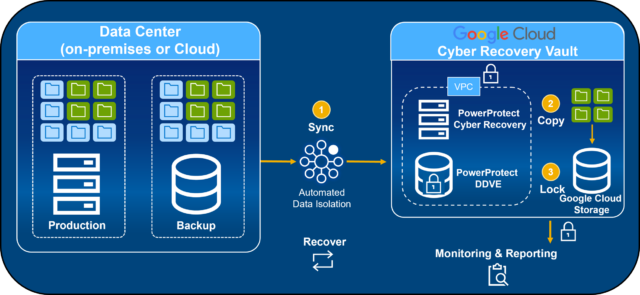Sunday, 27 November 2022
Secure, Isolate and Recover Critical Data with Google Cloud
Saturday, 26 November 2022
Demystifying Observability in the SRE Process
Brainstorm with Subject Matter Experts
Set Up KPIs and Scoring
Putting Everything Together
Thursday, 24 November 2022
64 x 400GbE: A Faster, Greener Data Center
Tuesday, 22 November 2022
Bringing Dell Data Services and Software Innovations to AWS
Delivering Enterprise Storage Capabilities to AWS
Enhancing Cyber Resiliency and Modern Data Protection in AWS
Bringing Amazon EKS Anywhere On-premises
Building a Cloud Strategy That Works for You with Dell Services
Spend Time with Us at AWS re:Invent
Sunday, 20 November 2022
Managing Your Organization’s Digital Transformation Costs with Dell APEX
Why Multicloud Matters
Multicloud Benefits and Challenges
IaaS is an Answer
Saturday, 19 November 2022
Enabling Open Embedded Systems Management on PowerEdge Servers
Open-source Software with OpenBMC
Open Ecosystem Embedded Software = Dell Open Server Manager
Security, Support and Manageability
Friday, 18 November 2022
Coming Soon: Backup Target from Dell APEX
Thursday, 17 November 2022
Build the Private 5G Network of Your Dreams
Time for a Renovation
Reconstruct Your Connectivity Solutions
Call In the Experts
Tuesday, 15 November 2022
Shift into High Gear with High Performance Computing
Today’s racing teams need to extract every bit of performance out of their cars and technical teams to succeed in such a competitive sport. They rely on high performance computing to not only design their cars and engines but to analyze race telemetry and make timely decisions that get them to the finish line first.
High Performance Computing also provides data-driven insights in other industries, leading to significant innovation. The power of HPC to discover is increasing the pressure on organizations to deploy more HPC workloads faster. Additionally, new capabilities in artificial intelligence and machine learning are expanding the scope and complexity of HPC workloads.
The implementation and ongoing management of HPC is complex and not suited for many IT organizations. The primary obstacles are financial limitations, insufficient in-house HPC expertise and concerns about keeping data secure. Dell APEX High Performance Computing helps solve these issues so you too can shift your HPC workloads into high gear.
Start in the Pole Position
A managed HPC platform that is ready for you to run your workloads is the best starting point. Dell APEX High Performance Computing provides:
◉ All you need to run your workloads: including hardware and HPC management software consisting of NVIDIA Bright Cluster Manager, Kubernetes or Apptainer/Singularity container orchestration and a SLURM® job scheduler.
◉ Managed HPC platform: eliminate the internal time and specialized skills required to design, procure, deploy and maintain HPC infrastructure and management software, so you can focus your resources on your HPC workloads.
◉ Convenient monthly payment: skip upfront HPC capital expenditures with a 1-, 3- or 5- year subscription that can be applied as an operating expense.
◉ Easy to order: choose between validated designs for Life Sciences or Digital Manufacturing while at the same time having flexibility on basic requirements, like capacity, processor speed, memory, GPU’s, networking and containers.
◉ Flexible capacity: additional compute power and storage that Dell makes available beyond your committed capacity so you can scale resources to meet periods of peak demand.
◉ Customer Success Manager: your main point of contact and a trusted advisor throughout your Dell APEX High Performance Computing journey.
Rely on a Skilled Pit Crew
A good race team doesn’t need a pit crew for just speedy fill-ups and tire changes, they are essential to the ongoing maintenance and fine-tuning of the race car. With APEX High Performance Computing, a Customer Success Manager is your crew chief, coordinating Dell technicians in charge of platform installation and configuration, 24×7 HPC platform performance and capacity monitoring, ongoing software and hardware upgrades, 24×7 proactive solution-level hardware and software support and onsite data sanitization with certification.
Safety First
In racing, it is imperative to implement the features that will keep the drivers safe in their seat. With Dell APEX High Performance Computing, we deploy your HPC solution securely in your datacenter. The infrastructure is dedicated to your organization, and not shared with other tenants through partitioning. This is ideal if you process sensitive or proprietary data that you need to keep safe, as follows.
◉ Keep your data close: minimize data latency and keep it secure in your datacenter, avoiding the need to migrate large amounts of sensitive data to the public cloud
◉ Lifecycle management: one of the most important features of our managed service is the regular updating of the system and HPC management software codes to ensure the most recent security patches are in place
Get to the Winner’s Podium
Our solutions are based on Dell Validated Designs with state-of-the-art hardware optimized for Life Sciences and Digital Manufacturing workloads. But even the fastest race cars require ongoing maintenance to stay in the race. Dell APEX High Performance Computing includes ongoing system monitoring, tuning and support and regular updating of hardware and software to ensure your workloads run on reliable, optimized systems.
Strong Partnerships Win Races
Many industries count on Dell to help them steer through the complexities of High Performance Computing, including Formula 1 racing teams. You too can count on Dell to manage your HPC infrastructure, backed by our deep global IT expertise, so you can focus on what you do best: discover and innovate.
Source: dell.com























